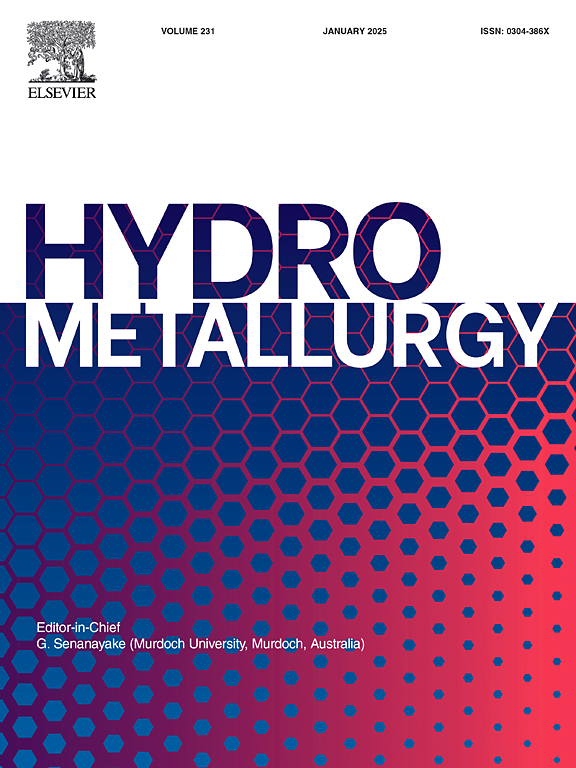A review of flowsheets for tungsten recovery from scheelite, wolframite and secondary resources and challenges for sustainable production
IF 4.8
2区 材料科学
Q1 METALLURGY & METALLURGICAL ENGINEERING
引用次数: 0
Abstract
Tungsten finds numerous industrial applications owing to its excellent physicochemical properties and applications in high-tech material production, which make tungsten containing ores, minerals and scrap material strategic raw materials/resources. Tungsten extractive metallurgy (TEM) is a vital process in the tungsten industry for producing diverse high-purity products from raw tungsten-containing minerals. This paper systematically reviews the flowsheets of TEM processes and related sustainability challenges, providing valuable insights and establishing guidelines for making these processes more eco-friendly and economically viable. Classical early-stage TEM processes primarily rely on the decomposition of scheelite (CaWO4) by HCl and feature lengthy procedures, low WO3 recoveries, and a high reagent consumption. In comparison, recently developed flowsheets combine NaOH/soda high-pressure digestion and solvent extraction/ion exchange which offer several advantages: (i) high raw material adaptability, (ii) high tungsten utilization efficiency, (iii) high product quality, and (iv) operation simplicity. However, recently developed flowsheets exhibit several drawbacks: (i) high reagent consumption, (ii) discharge of large volumes of high-salinity wastewater, and (iii) production of alkaline leach residues classified as hazardous solid waste. Although recent developments have partially addressed the issues of wastewater and residue discharge, further research is required to assess the economic viability of these processes and their adaptability to raw materials. A sustainable TEM process requires the consideration of both practicality and eco-friendliness in the flowsheets, including the following: (i) adaptability to the growing complexity of raw materials, (ii) tungsten utilization efficiency, (iii) solution recycling, and (iv) comprehensive utilization of other valuable components. This study aims to provide insights into TEM flowsheets and establish guidelines for the development of environmentally friendly and economical processes.
评述了从白钨矿、黑钨矿和二次资源中回收钨的流程及可持续生产面临的挑战
钨因其优异的物理化学性质和在高科技材料生产中的应用而获得了许多工业应用,这使含钨矿石、矿物和废料成为战略原料/资源。钨萃取冶金(TEM)是钨工业中从含钨矿物原料中生产各种高纯度产品的重要工艺。本文系统地回顾了TEM工艺流程和相关的可持续性挑战,提供了有价值的见解,并建立了指导方针,使这些工艺更加环保和经济可行。经典的早期TEM过程主要依赖于盐酸对白钨矿(CaWO4)的分解,过程漫长,WO3回收率低,试剂消耗高。相比之下,最近开发的工艺流程结合了NaOH/soda高压消解和溶剂萃取/离子交换,具有以下几个优点:(i)原料适应性强,(ii)钨利用率高,(iii)产品质量高,(iv)操作简单。然而,最近开发的流程显示出几个缺点:(i)高试剂消耗,(ii)排放大量高盐度废水,以及(iii)产生被归类为危险固体废物的碱性浸出渣。虽然最近的发展已经部分解决了废水和残渣排放的问题,但还需要进一步的研究来评估这些工艺的经济可行性及其对原材料的适应性。一个可持续的瞬变电磁法流程需要在流程中考虑实用性和生态友好性,包括以下几点:(i)对日益复杂的原材料的适应性,(ii)钨的利用效率,(iii)溶液的回收利用,以及(iv)对其他有价值成分的综合利用。本研究旨在提供对瞬变电磁法流程的见解,并为开发环保和经济的工艺建立指导方针。
本文章由计算机程序翻译,如有差异,请以英文原文为准。
求助全文
约1分钟内获得全文
求助全文
来源期刊

Hydrometallurgy
工程技术-冶金工程
CiteScore
9.50
自引率
6.40%
发文量
144
审稿时长
3.4 months
期刊介绍:
Hydrometallurgy aims to compile studies on novel processes, process design, chemistry, modelling, control, economics and interfaces between unit operations, and to provide a forum for discussions on case histories and operational difficulties.
Topics covered include: leaching of metal values by chemical reagents or bacterial action at ambient or elevated pressures and temperatures; separation of solids from leach liquors; removal of impurities and recovery of metal values by precipitation, ion exchange, solvent extraction, gaseous reduction, cementation, electro-winning and electro-refining; pre-treatment of ores by roasting or chemical treatments such as halogenation or reduction; recycling of reagents and treatment of effluents.
 求助内容:
求助内容: 应助结果提醒方式:
应助结果提醒方式:


